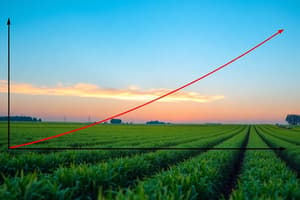Podcast
Questions and Answers
What is the main focus of supply-side economics?
What is the main focus of supply-side economics?
- Increasing government revenue
- Expanding social welfare programs
- Promoting economic growth (correct)
- Decreasing government spending
What is the Laffer curve?
What is the Laffer curve?
- A graph of government spending over time
- A measure of income inequality
- A model of international trade
- A theoretical relationship between tax rates and government revenue (correct)
What is the postulate of supply-side economics embodied by the Laffer curve?
What is the postulate of supply-side economics embodied by the Laffer curve?
- Tax rates and tax revenues are inversely related
- Tax rates have no effect on government revenue
- Tax rates and tax revenues are distinct (correct)
- Tax rates and tax revenues are the same
What is the 'Kansas experiment'?
What is the 'Kansas experiment'?
What is the aim of China's supply-side structural reforms?
What is the aim of China's supply-side structural reforms?
What are the four key areas of China's supply-side structural reforms?
What are the four key areas of China's supply-side structural reforms?
What are some criticisms of supply-side economics?
What are some criticisms of supply-side economics?
What is Made in China 2025?
What is Made in China 2025?
What is the economic effect of the Trump tax overhaul?
What is the economic effect of the Trump tax overhaul?
Flashcards
Supply-side economics
Supply-side economics
A macroeconomic theory advocating lower taxes, deregulation, and free trade to boost economic growth.
Laffer Curve
Laffer Curve
A theory showing the relationship between tax rates and government revenue.
Taxation Impact
Taxation Impact
Lower taxes can increase economic activity and encourage investment, leading to greater specialization and efficiency.
Tax Cuts Effect
Tax Cuts Effect
Signup and view all the flashcards
Trump Tax Cuts
Trump Tax Cuts
Signup and view all the flashcards
China’s Supply-Side Reform
China’s Supply-Side Reform
Signup and view all the flashcards
Key Reform Areas
Key Reform Areas
Signup and view all the flashcards
Additional Reforms
Additional Reforms
Signup and view all the flashcards
Deleveraging Methods
Deleveraging Methods
Signup and view all the flashcards
Study Notes
Supply-side economics is a macroeconomic theory that advocates for lowering taxes, decreasing regulation, and allowing free trade to foster economic growth. The Laffer curve, a theoretical relationship between tax rates and government revenue, is a basis of supply-side economics. Supply-side economics rose in popularity among Republican Party politicians from 1977 onwards. The main focus of supply-side economics is promoting economic growth, and marginal tax rates play a significant role in determining the development of the economy. The Laffer curve embodies a postulate of supply-side economics: that tax rates and tax revenues are distinct, with government tax revenues the same at a 100% tax rate as they are at a 0% tax rate and maximum revenue somewhere in between these two values. Supply-side economics has been promoted by Republican politicians, including Ronald Reagan, and has been criticized for failing to produce the expected results. The "Kansas experiment" was a real-life test of supply-side economics, but by 2017, state revenues had fallen by hundreds of millions of dollars causing spending on roads, bridges, and education to be slashed, and growth in Kansas remained consistently below average.Supply-Side Economics: Theory and Examples
-
Supply-side economics suggests that increased taxation reduces economic activity and discourages investment, leading to lower levels of specialization and lower economic efficiency.
-
Supply-side economists argue that shifting the aggregate supply curve outward through tax cuts results in expanded output and employment, and prices can be lowered.
-
Studies show that while tax cuts increase economic growth, the increased revenue from that growth at the new lower tax rates are only enough to make up for 10-30% of the tax cuts, meaning that spending cuts must also be made to avoid deficits.
-
The Trump administration implemented individual and corporate income tax cuts in 2018, and proponents of supply-side economics such as Laffer, Moore, and Kudlow played prominent roles in formulating Trump's economic policies.
-
Some economists have criticized supply-side economics, with Alan Blinder calling it an "ill-fated" and perhaps "silly" school of thought, and Greg Mankiw stating that tax cuts rarely pay for themselves.
-
The Laffer curve, which illustrates the relationship between tax rates and government revenue, has been used to justify tax cuts, but the notion that tax cuts increase revenue has been criticized.
-
Tax cuts enacted in the 1920s and 1960s have been cited as evidence that tax cuts can increase tax revenue, but studies have shown mixed results.
-
Reagan's tax cuts during the 1980s were justified by supply-siders claiming they would result in net increases in tax revenue, but tax revenues declined, and the deficit increased.
-
Bush's tax cuts in the early 2000s were criticized for not paying for themselves and increasing the deficit.
-
The Trump tax overhaul has led to increased economic growth but has also resulted in a decline in federal revenues, and little if any economic growth in 2018 could be attributed to it.China’s Supply-side Structural Reform:
-
China’s economic growth slowed for the first time since the 1970s.
-
China’s President announced supply-side structural reforms in 2015 to combat the slowing economic growth.
-
The aim of the reforms is to increase total factor productivity through investment in technological improvements.
-
The reforms focus on four key areas: reducing excess industrial capacity, reducing leverage in the corporate sector, reducing property inventories, and lowering costs for new enterprises.
-
The reduction of excess industrial capacity focuses on sectors like coal, steel, and electricity generation.
-
The government encouraged mergers and acquisitions, direct financing, and debt-to-equity swaps to reduce leverage in the corporate sector.
-
Additional reforms include increased incentives for private sector investment, development of modern service industries, and increasing public goods and services supply.
-
The longer-term initiatives have also been accompanied by large-scale tax cuts.
-
Policies targeted toward new growth engine creation include Made in China 2025 and the Internet Plus agenda.
-
The adjustments to the industrial sector as a result of the early reform policies have been attributed to a nominal increase in GDP growth.
-
The economic effects of the COVID-19 pandemic impacted demand growth in China's domestic consumer market, which has slowed the effects of continued supply-side reforms.
-
Critics of supply-side policies emphasize the growing federal deficits, increased income inequality, and lack of growth.
Studying That Suits You
Use AI to generate personalized quizzes and flashcards to suit your learning preferences.




